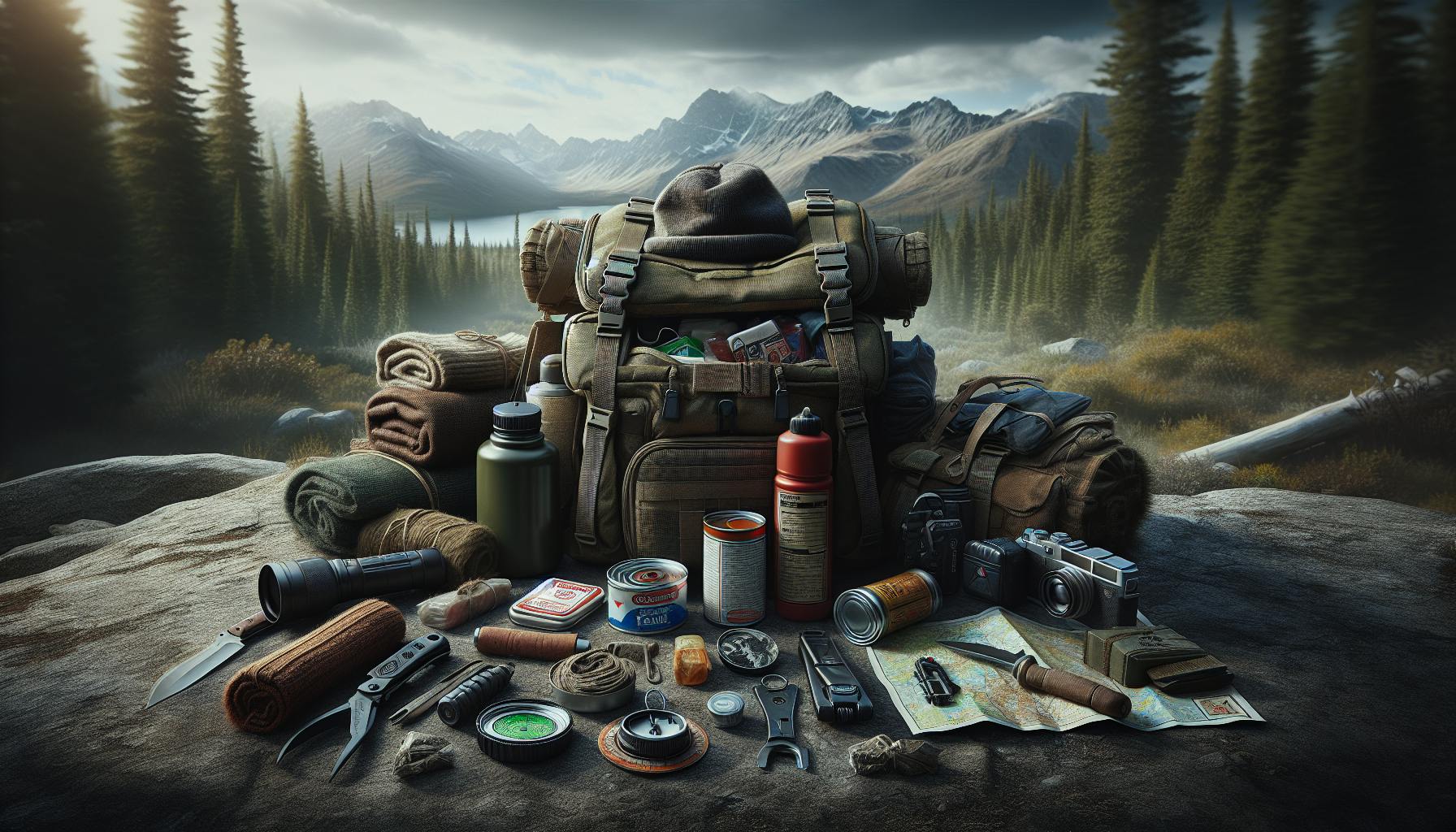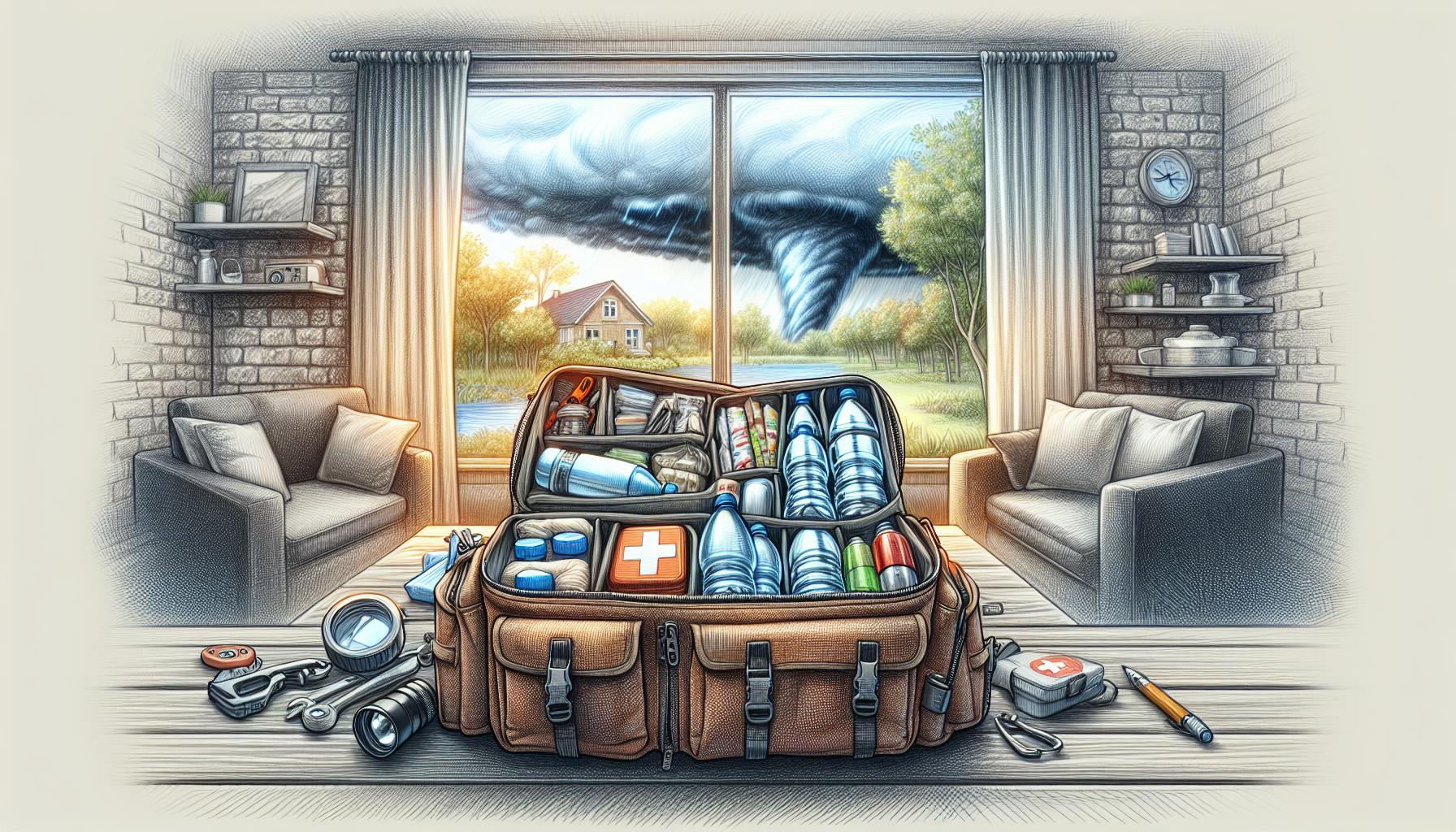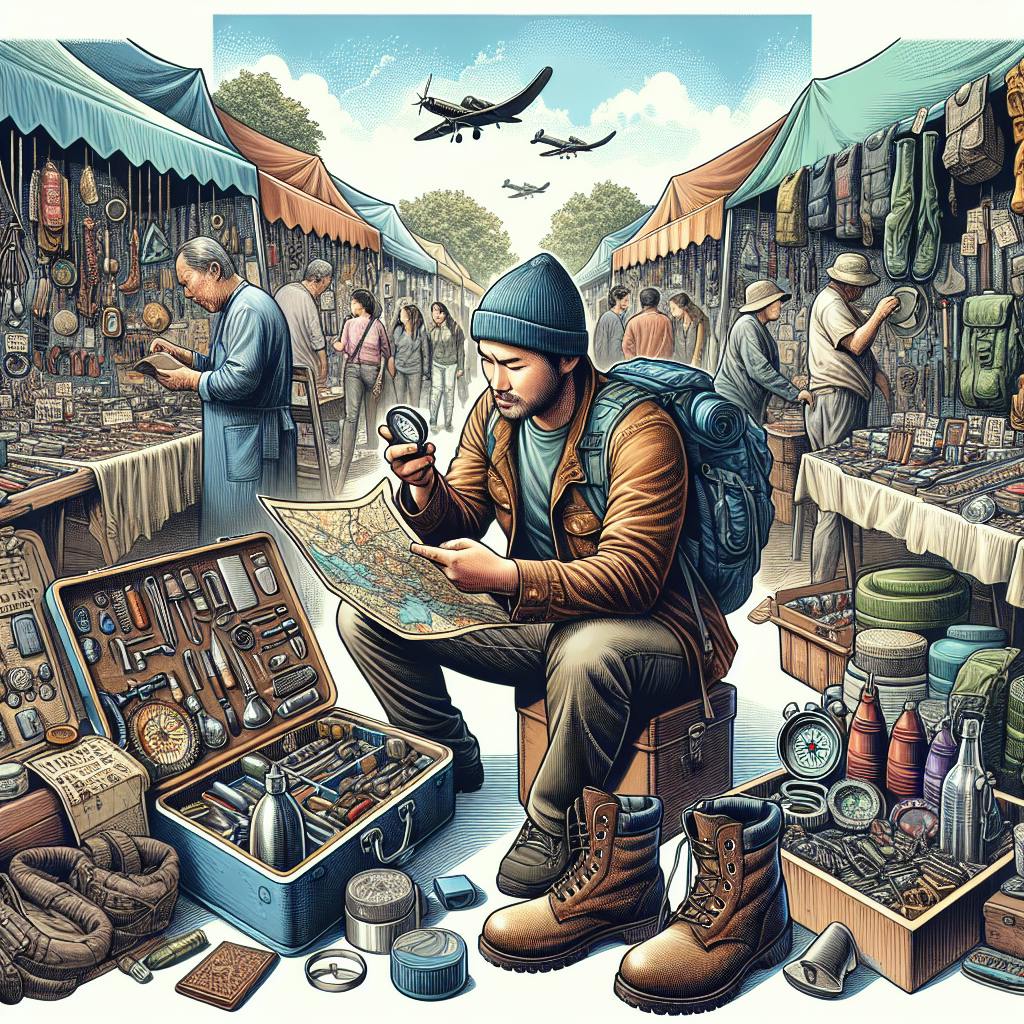When crisis strikes, having a well-stocked bug out bag can make all the difference for survival.
This guide will provide key considerations for purchasing a pre-made bug out kit to meet your family's needs, with tips on assessing quality, customization, and value for money.
We'll examine top brands, gear efficacy, core survival items, and additional equipment to equip you with the knowledge to select the ideal emergency preparedness kit.
Introduction to Bug Out Kits
A bug out kit is essential survival gear that contains supplies to help you safely evacuate or shelter in place during an emergency. This comprehensive guide will provide key factors to consider when purchasing premade bug out kits for sale.
Understanding the Concept of a Bug Out Kit
A bug out kit, also known as a tactical or go bag, is designed to provide critical tools and supplies to endure a disaster scenario or situation where you need to evacuate quickly. Key components include:
- Food and water for 72 hours
- First aid supplies and medications
- Tools like flashlights, pocket knives, duct tape
- Emergency shelter such as a tent or tarp
- Navigation items like maps, compass, GPS device
- Personal hygiene products and other essentials
Bug out bags play a vital role in emergency preparedness by equipping you with what you need to survive several days, whether sheltering or traveling to safety.
The Significance of Being Prepared
Having a reliable, well-stocked bug out bag ready in case of an emergency can truly mean the difference between life and death. Consider these scenarios:
- Natural disasters like floods, hurricanes, or wildfires necessitating evacuation
- Widespread power outages and infrastructure failure
- Pandemic outbreaks or other biological threats
- Civil unrest and violence disrupting supply chains
A bug out kit enables self-reliance and resilience no matter the situation. It provides assurance that you have access to basic provisions when stores may be closed, the grid is down, or it is unsafe to leave shelter.
Ultimately, the ability to safely evacuate or endure confinement can protect you and your loved ones.
Examining Premade Bug Out Kits
Purchasing a premade bug out bag offers convenience, saving you research and assembly time. However, examine options closely to ensure quality. Consider:
- Shelflife of food, water, medications
- Durability of backpack and tools
- Customization options to meet your needs
- Ability to replenish perishable items
The best kits allow flexibility to tailor the contents while providing essentials to start. Assess your climate, terrain, group size, and likely scenarios when choosing.
Quality premade kits with replenishment systems enable preparedness for the unexpected.
How to get free emergency kit?
The Federal Emergency Management Agency (FEMA) offers a free Emergency Financial First Aid Kit to help individuals and families prepare for unexpected disasters or emergencies.
To get your free emergency kit:
- Go to ready.gov, FEMA's disaster preparedness website
- Click on the button to "Order Your Free Kit"
- Fill out the request form with your name and contact information
- The kit will be mailed to you for free
The FEMA emergency kit includes a checklist of important financial documents and information you should have ready in case an emergency strikes. Having these critical items organized in advance will help you deal with the financial impacts of a disaster.
The free kit also contains useful templates and worksheets to create an emergency financial plan tailored to your household's unique needs.
With the FEMA Emergency Financial First Aid Kit, you'll have peace of mind knowing you've taken an important step towards emergency preparedness. It's a quick and easy way to start securing your family's financial future against the unexpected.
What should be in a bug out first aid kit?
A well-stocked first aid kit is an essential component of any bug out bag. Here are some of the key items to include:
Medications and Ointments
- Antibiotic ointment packets
- Anti-diarrheal medication
- Antihistamine tablets
- Aspirin or acetaminophen packets
- Electrolyte powder packets
Wound Care Supplies
- Adhesive bandages
- Gauze pads and rolls
- Medical tape
- Moleskin patches
- Tourniquet
Tools and Accessories
- Bandage scissors
- Cotton swabs
- Emergency blanket
- Exam gloves
- Tweezers
Other Recommended Items
- Alcohol wipes
- Insect repellent wipes
- Instant cold packs
- Medical mask
- Safety pins
- Sunscreen packets
Make sure to check expiration dates regularly and replace anything that is expired or close to expiration. It's also a good idea to take a first aid class so you know how to properly use all the items in your kit. With a well-stocked first aid kit, you'll be prepared to handle minor to moderate medical situations when bugging out.
What do you put in a 72-hour kit?
A well-stocked 72-hour emergency kit is an essential part of any prepper's bug out bag or disaster preparedness plan. Here are some of the most vital items to include:
Water
- 1 gallon of water per person per day for at least 3 days (for drinking and sanitation)
- Water purification tablets or filter
Food
- High-calorie, non-perishable food like granola bars, canned goods, dried fruits and nuts
- At least a 3-day supply
- Manual can opener
Tools and Supplies
- Battery-powered or hand crank radio
- Flashlight with extra batteries
- First aid kit
- Whistle
- Dust masks
- Duct tape and plastic sheeting
- Cash in small denominations
Clothing and Shelter
- Warm clothes, rain gear, sturdy shoes
- Emergency “space” blanket
- Tent or tarp
Sanitation and Hygiene
- Toilet paper
- Soap
- Feminine supplies
- Personal medications
Customizing your 72-hour kit to your family’s unique needs can help ensure you have the essentials during an emergency evacuation or power outage. Periodically taking inventory and replacing expired items also helps your bug out bag stay prepared.
What is a good bug out bag?
A quality bug out bag should contain the essentials to survive for at least 72 hours in an emergency situation. The key components of a well-stocked bug out bag include:
Food and Water
Having an adequate supply of food and water is critical in a bug out scenario. Experts recommend packing at least a 3-day supply of non-perishable, high-calorie foods such as protein bars, dried fruits and nuts. For water, pack at least 1 gallon per person for 3 days. Water purification tablets or a portable water filter can help ensure safe drinking water.
First Aid Supplies
A comprehensive first aid kit can help treat injuries and illness when medical care is limited. Be sure to pack bandages, gauze, medications, tools (scissors, tweezers), etc. Specialized items like a SAM splint or tourniquet could also prove invaluable.
Navigation Tools
Having maps, a compass, GPS device and other navigation gear will help you find your way if you become lost or disoriented. Know how to use these tools effectively.
Light Sources
Pack multiple light sources like flashlights, glow sticks and headlamps. Having backup batteries/charging methods helps avoid getting caught in the dark. Reflective gear also improves visibility.
Shelter and Bedding
A tent, tarp and sleeping bag provide portable shelter. Other useful items include a bivy sack, blankets and emergency thermal blankets.
Communication Devices
Pack both electronic devices like radios and cell phones as well as non-electronic signal devices. A hand crank or battery-powered radio keeps you updated about the situation. Whistles, signal mirrors and flares help rescuers locate you.
Tools and Weapons
Tools for securing food/water, making repairs, self-defense, etc. are extremely beneficial. Quality knives, multi-tools, paracord, firearms, pepper spray provide utility and protection.
With the right selection of gear and supplies, a bug out bag offers an invaluable insurance policy whenever disaster strikes. Prior proper planning prevents poor performance - make sure yours is prepared!
sbb-itb-b932644
Essential Elements of the Ultimate Survival Kit
Disaster preparedness often starts with having a well-stocked bug out bag. When compiling your bug out kit, focus on the core essentials for survival:
Sustenance Supplies: Water and Food Rations
- Pack at least 1 gallon of water per person per day for 3 days. Choose durable, BPA-free water bottles and water purification tablets.
- Include high-calorie, non-perishable foods like protein bars, nuts, jerky, and MREs (Meals Ready-to-Eat).
- Focus on nutrient-dense foods that provide energy and keep you hydrated.
Bug Out Bag Medical Kit List: First Aid Essentials
- A first aid kit helps treat injuries, burns, or illness when medical care is limited.
- Essentials include bandages, gauze, scissors, antibiotic ointment, pain meds, safety pins, and latex gloves.
- Also pack prescriptions, OTC meds, thermometer, tweezers, and other personal care items.
Survival Tools and Self-Defense Equipment
- Pack tools for building shelter, starting fires, and signaling like a pocket knife, lighter, flashlight, rope, and duct tape.
- Pepper spray, alarms, or other legal self-defense items can provide protection if needed.
Communication and Navigation Gear
- CB radios, emergency whistles, signal mirrors, and flares enable contacting rescuers.
- Topo maps, lensatic compass, GPS device, and weather radio assist navigation and monitoring conditions.
Focus on quality gear that meets your unique needs. Test and customize your bug out bag so you have confidence in your preparedness plan.
Customizing Your Bug Out Bag: The Bug Out Bag Builder Approach
Customizing your bug out bag is key to ensuring you have the right supplies and gear for your specific needs and situation. The Bug Out Bag Builder approach allows you to tailor your kit beyond just a one-size-fits-all premade option.
Tailoring to Your Region: Climate and Terrain
The contents of your bug out bag should be adapted to the climate, terrain, and risks common in your region. Those living in cold winter climates need extra layers and insulation compared to those in more temperate areas. If you live somewhere prone to earthquakes, floods, or hurricanes, include region-specific gear. Customize with items like flashlights, ropes, camping stove, maps, and compass.
Personal and Family Needs
Take into account individual skills, ages, health issues, and medications when packing your bag. If you have children, include activities to keep them occupied. Those with medical conditions should pack extra medications and supplies. Tailor the bag to complement each person's existing knowledge - packing fishing gear for the angler in your family.
Balancing Cost and Customization
While buying a premade bug out bag is cheaper, customizing allows you to address personal needs. Focus first on water, food, shelter, navigation and medical supplies. Then add supplemental items within your budget. Building your own over time also spreads costs out. Leverage your existing camping/hiking equipment to offset expenses.
Selecting the Best Bug Out Bag Kit for Sale
When selecting a premade bug out bag kit for sale, there are a few key factors to consider to ensure you get the best value for your money:
Identifying Top Brands for Reliability
Some well-known brands that produce high-quality and reliable bug out bags include:
- 5.11 Tactical
- REI
- Life Gear
- Emergency Zone
- Ready America
These companies use durable materials and components tested to withstand harsh conditions. Purchasing from an established brand provides confidence in the bag's resilience.
Assessing the Durability of the Tactical Bug Out Bag
Key features that contribute to a bug out bag's durability include:
- Water-resistant fabrics like vinyl, polyester, nylon to keep contents dry
- Reinforced stitching at stress points prevents ripping
- Rugged zippers that won't easily break
- Padded straps for comfortable carrying
- Integrated molle system to attach additional pouches and gear
Testing reviews ensure the bug out bag can withstand the elements.
Evaluating Gear Quality and Efficacy
The gear inside a bug out bag kit should meet survival standards. Assess:
- Useful tools like knives, fire starters, flashlights
- Adequate food/water for 72+ hours
- Weather-appropriate clothing and blankets
- First aid supplies to treat injuries
- Navigation aids like map, compass, GPS
- Communication devices like emergency radio
- Personal hygiene items
Quality gear tailored to risks in your region improves preparedness.
Determining Value for Money
To evaluate the cost-effectiveness of a bug out bag:
- Compare retail prices from various sellers
- Consider discounts on premade kits
- Review contents to tally gear value
- Ensure bag meets your packing needs
Seeking sales and validating the completeness of the premade bug out bag contents can maximize value.
Comprehensive Bug Out Bag List: What to Look For
When preparing your bug out bag, having a comprehensive checklist is crucial to ensure you have all the gear and supplies needed to survive an emergency situation. Here are some key categories to consider when packing your bug out bag:
Core Survival Items
These basic items should form the foundation of any solid bug out bag:
-
Water and food rations - Pack enough non-perishable food like granola bars, dried fruits, beef jerky, and MREs to last 3-5 days. Bring a portable water filter or purification tablets as well. Having adequate sustenance is critical.
-
First aid kit - This should include bandages, gauze, medicines, etc. to treat injuries and ailments. Consider your specific medical needs as well.
-
Knives - Bring at least one fixed-blade knife for preparing food and making shelters. Folding knives can serve as useful backup tools.
-
Fire starters - Matches, lighters, fire steel, and tinder help start campfires for cooking, warmth, and signaling. Waterproof them well.
-
Shelter supplies - Pack an emergency tent, tarp, rope, duct tape, and even emergency blanket for protection from the elements.
Additional Gear for Extended Survival
If planning to bug out for longer periods, also consider packing:
-
Communication devices - Hand crank or solar powered radios, whistles, flares and satellite communicators to call for help.
-
Light sources - Flashlights, glow sticks, headlamps and batteries provide light when dark.
-
Cooking gear - Compact camping stoves, mess kits, utensils and cups make meal preparation easier.
-
Tools - Hatchets, folding saws, multi tools and paracords help construct shelters, gather firewood and make repairs.
-
Navigation - Maps, compass, GPS device and personal locator beacons to navigate unfamiliar terrain.
Custom Add-Ons for Special Circumstances
Depending on your needs, also think about:
-
Prescription medications - If relying on specific meds, pack extra doses.
-
Infant and child care items - Diapers, formula, toys if bugging out with babies or kids.
-
Pet supplies - Food, bowls, leashes, etc. for bugging out with pets.
-
Entertainment - Deck of cards, books, portable chargers and headphones make downtime more bearable.
Having a comprehensive checklist ensures your bug out bag has all the gear, tools and supplies to survive short and long-term emergencies. Customize based on your specific needs and circumstances.
Key Takeaways
Investing in a high-quality bug out kit can provide essential support during an emergency. When selecting a kit, prioritize durability, versatility, and comprehensive coverage of survival needs.
The optimal bug out bag should contain shelter, water, food, first aid, navigation, lighting, tools, and other critical supplies. Carefully assess whether to build your own kit or purchase a pre-made option based on your skills, budget, and specific requirements.
An equipped bug out bag delivers long-term preparedness. Assembling the resources before an unexpected crisis strikes enables rapid response and potentially life-saving self-reliance. With research and forethought, a bug out kit can offer adaptable, reliable crisis insurance.
The Importance of Quality and Preparedness
A bug out kit designed for emergency scenarios must provide resilient, versatile support. Prioritizing quality gear and supplies that can withstand tough conditions is essential. Rushed, last-minute purchases often prove unreliable when tested by real-world survival challenges. Investing extra time and budget into thoughtful choices pays off through boosted confidence and readiness.
Making Informed Purchasing Decisions
Those seeking bug out kits for sale face the decision between pre-made kits or building their own. Pre-made options provide turnkey convenience, while DIY assembly allows complete personalization. Carefully weigh factors like budget, skill level, kit composition, and brand reputation when deciding. Creating detailed checklists of must-have survival items helps guide purchasing choices. Vetting online customer reviews also lends insight into real-world performance.
Long-Term Benefits of a Well-Equipped Bug Out Kit
An emergency can strike suddenly, making reliable crisis response tools invaluable. A well-equipped bug out bag delivers vital insurance through supplies, knowledge, and preparedness. With an appropriate kit, the ability to rapidly shelter, navigate, administer first aid, and sustain oneself remains close at hand. The peace of mind and life-saving potential of a thoughtfully packed bug out bag proves its worth during unexpected disasters. Assembling supplies before emergencies promotes safety and self-reliance when they count most.


